ACCT20074 Contemporary Accounting Theory: Practical Report Analysis
VerifiedAdded on 2023/03/31
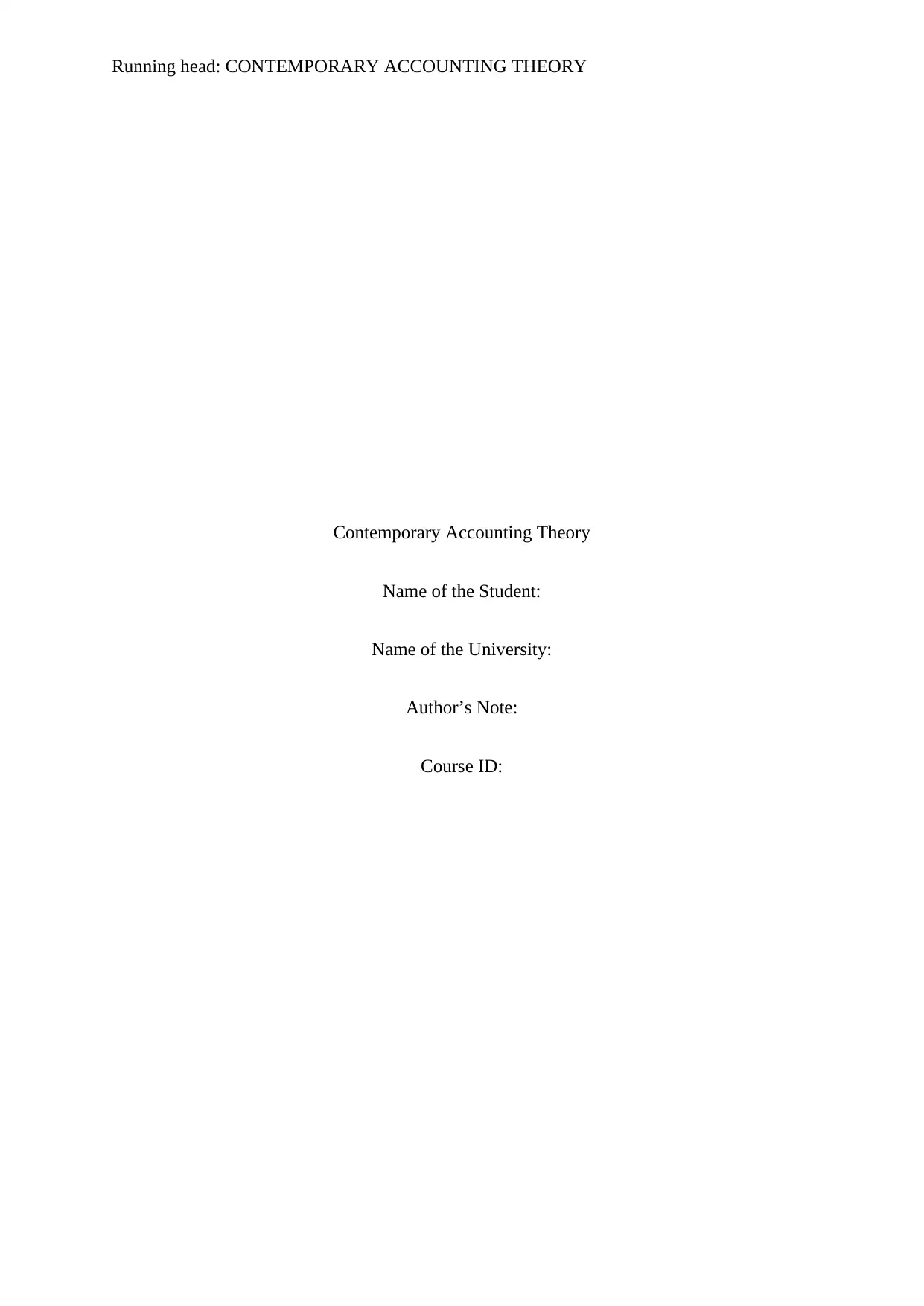
Contemporary Accounting Theory
Name of the Student:
Name of the University:
Author’s Note:
Course ID:
Paraphrase This Document
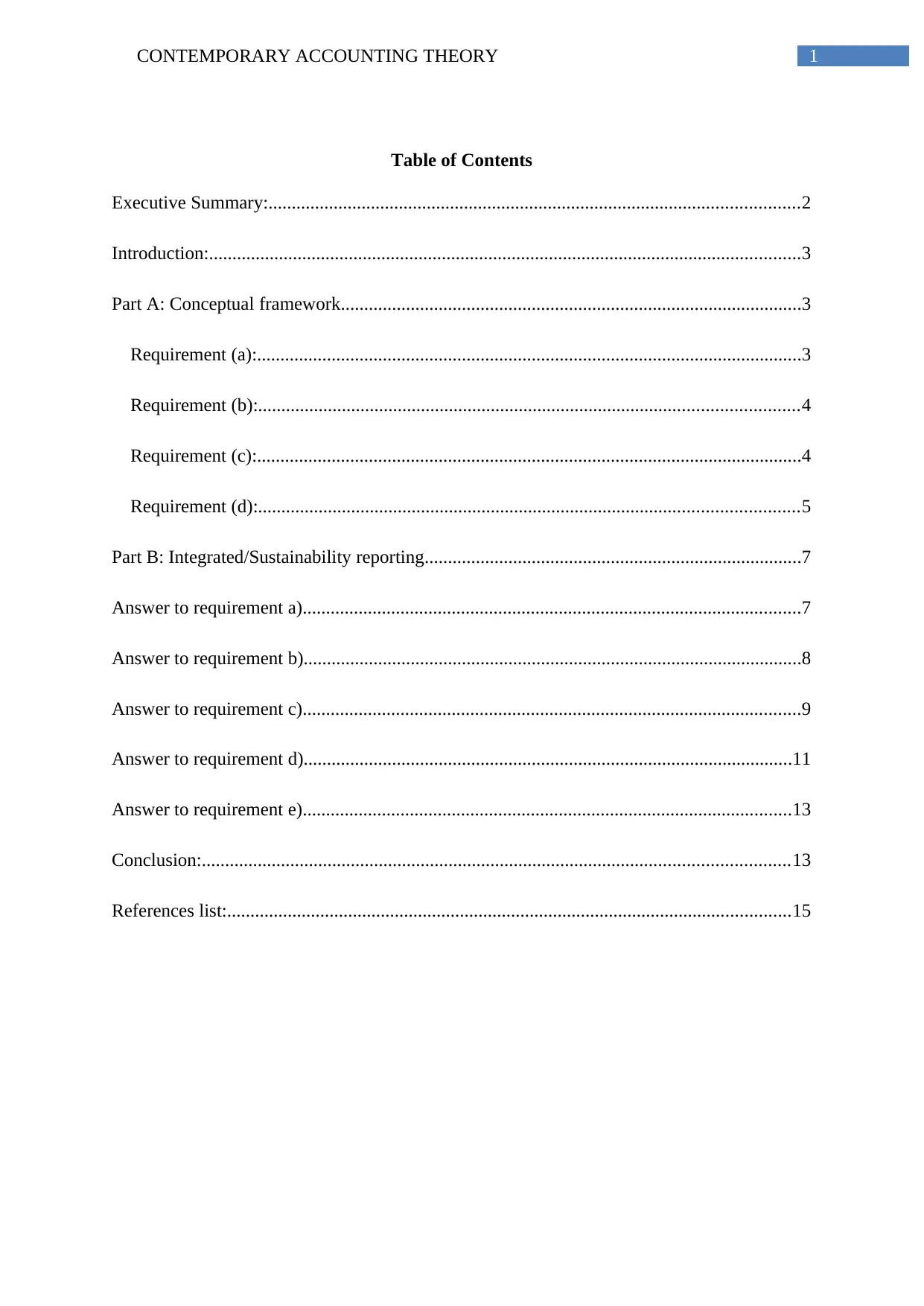
Table of Contents
Executive Summary:..................................................................................................................2
Introduction:...............................................................................................................................3
Part A: Conceptual framework...................................................................................................3
Requirement (a):.....................................................................................................................3
Requirement (b):....................................................................................................................4
Requirement (c):.....................................................................................................................4
Requirement (d):....................................................................................................................5
Part B: Integrated/Sustainability reporting.................................................................................7
Answer to requirement a)...........................................................................................................7
Answer to requirement b)...........................................................................................................8
Answer to requirement c)...........................................................................................................9
Answer to requirement d).........................................................................................................11
Answer to requirement e).........................................................................................................13
Conclusion:..............................................................................................................................13
References list:.........................................................................................................................15
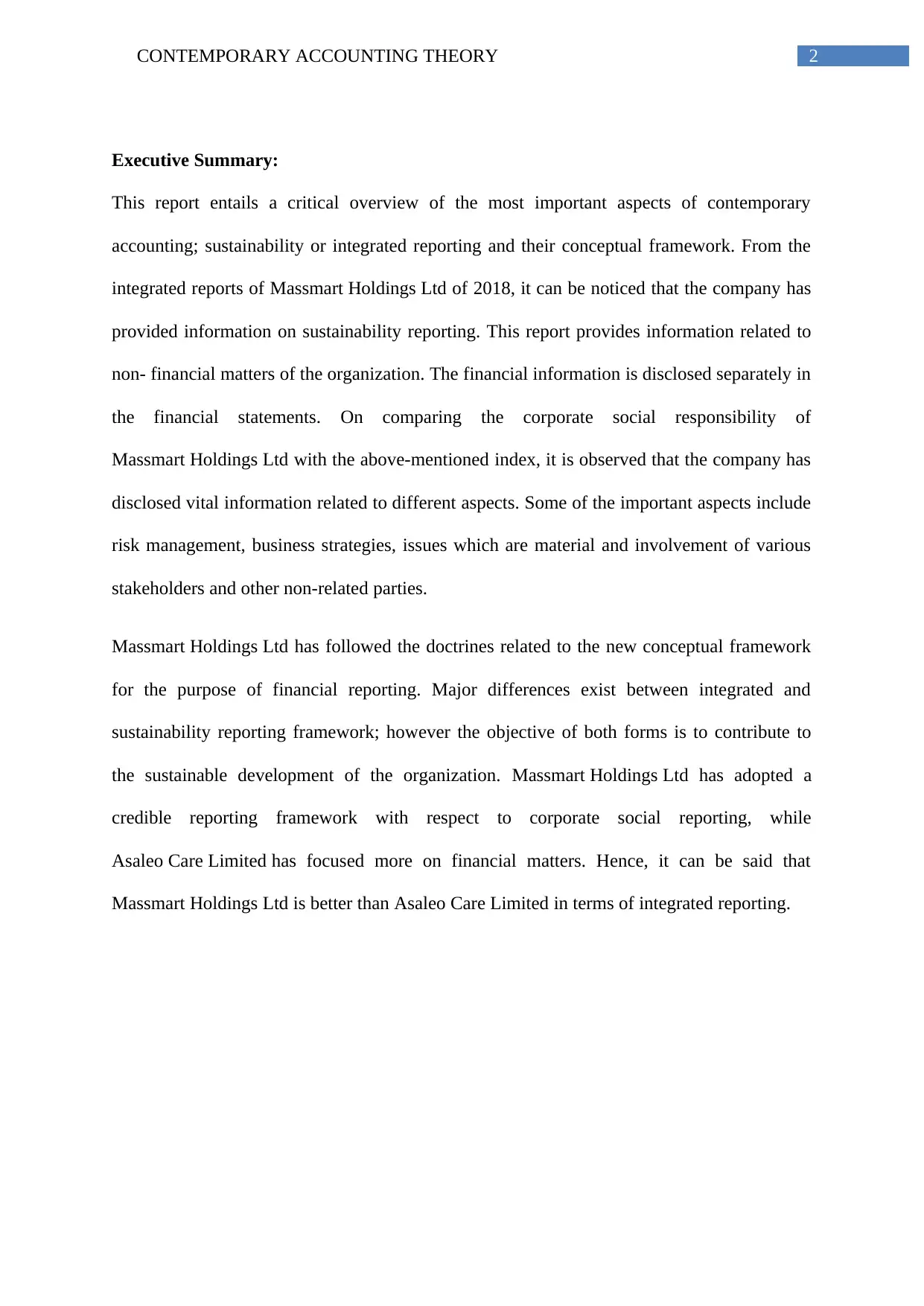
Executive Summary:
This report entails a critical overview of the most important aspects of contemporary
accounting; sustainability or integrated reporting and their conceptual framework. From the
integrated reports of Massmart Holdings Ltd of 2018, it can be noticed that the company has
provided information on sustainability reporting. This report provides information related to
non- financial matters of the organization. The financial information is disclosed separately in
the financial statements. On comparing the corporate social responsibility of
Massmart Holdings Ltd with the above-mentioned index, it is observed that the company has
disclosed vital information related to different aspects. Some of the important aspects include
risk management, business strategies, issues which are material and involvement of various
stakeholders and other non-related parties.
Massmart Holdings Ltd has followed the doctrines related to the new conceptual framework
for the purpose of financial reporting. Major differences exist between integrated and
sustainability reporting framework; however the objective of both forms is to contribute to
the sustainable development of the organization. Massmart Holdings Ltd has adopted a
credible reporting framework with respect to corporate social reporting, while
Asaleo Care Limited has focused more on financial matters. Hence, it can be said that
Massmart Holdings Ltd is better than Asaleo Care Limited in terms of integrated reporting.
⊘ This is a preview!⊘
Do you want full access?
Subscribe today to unlock all pages.

Trusted by 1+ million students worldwide
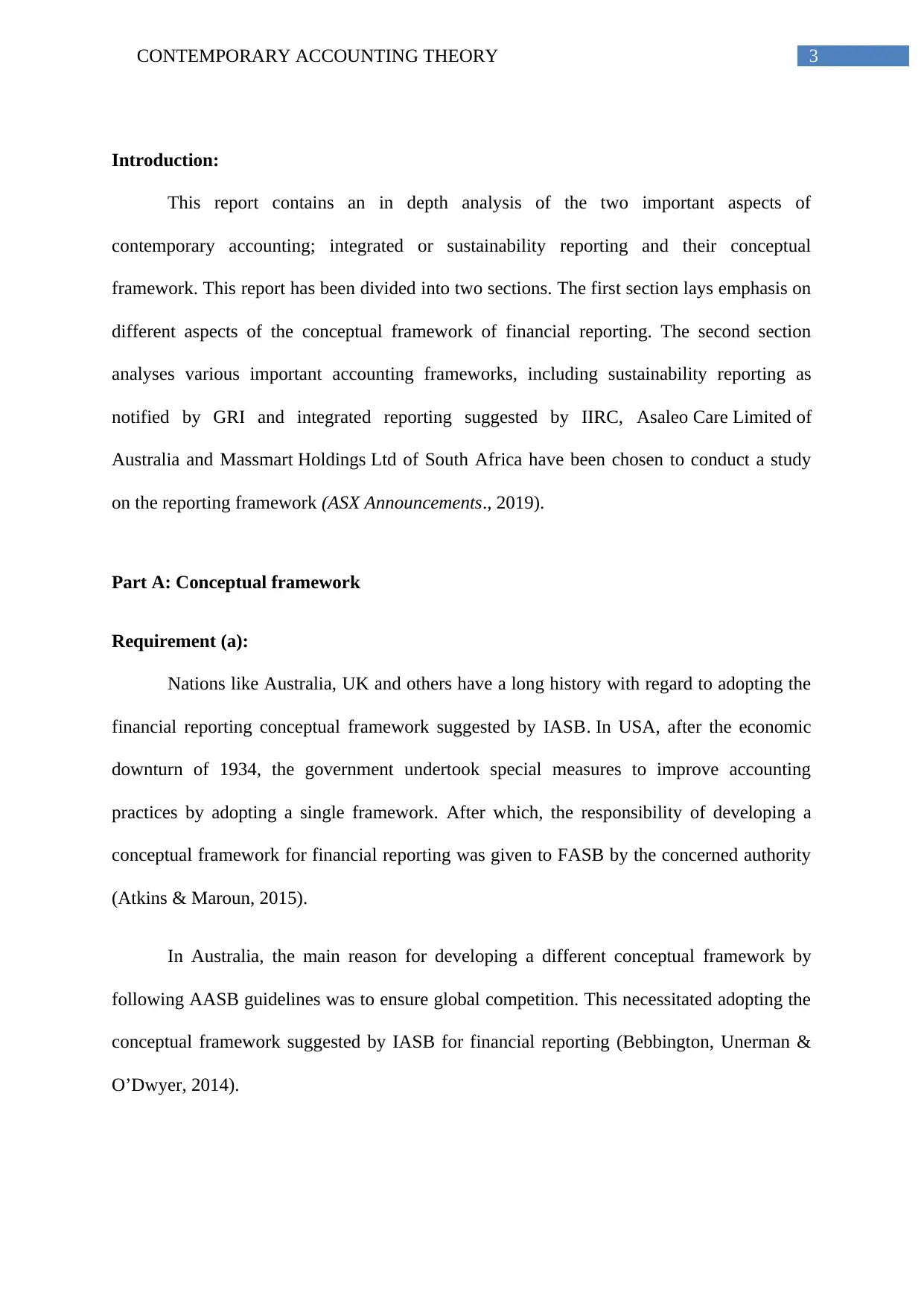
Introduction:
This report contains an in depth analysis of the two important aspects of
contemporary accounting; integrated or sustainability reporting and their conceptual
framework. This report has been divided into two sections. The first section lays emphasis on
different aspects of the conceptual framework of financial reporting. The second section
analyses various important accounting frameworks, including sustainability reporting as
notified by GRI and integrated reporting suggested by IIRC, Asaleo Care Limited of
Australia and Massmart Holdings Ltd of South Africa have been chosen to conduct a study
on the reporting framework (ASX Announcements., 2019).
Part A: Conceptual framework
Requirement (a):
Nations like Australia, UK and others have a long history with regard to adopting the
financial reporting conceptual framework suggested by IASB. In USA, after the economic
downturn of 1934, the government undertook special measures to improve accounting
practices by adopting a single framework. After which, the responsibility of developing a
conceptual framework for financial reporting was given to FASB by the concerned authority
(Atkins & Maroun, 2015).
In Australia, the main reason for developing a different conceptual framework by
following AASB guidelines was to ensure global competition. This necessitated adopting the
conceptual framework suggested by IASB for financial reporting (Bebbington, Unerman &
O’Dwyer, 2014).
Paraphrase This Document
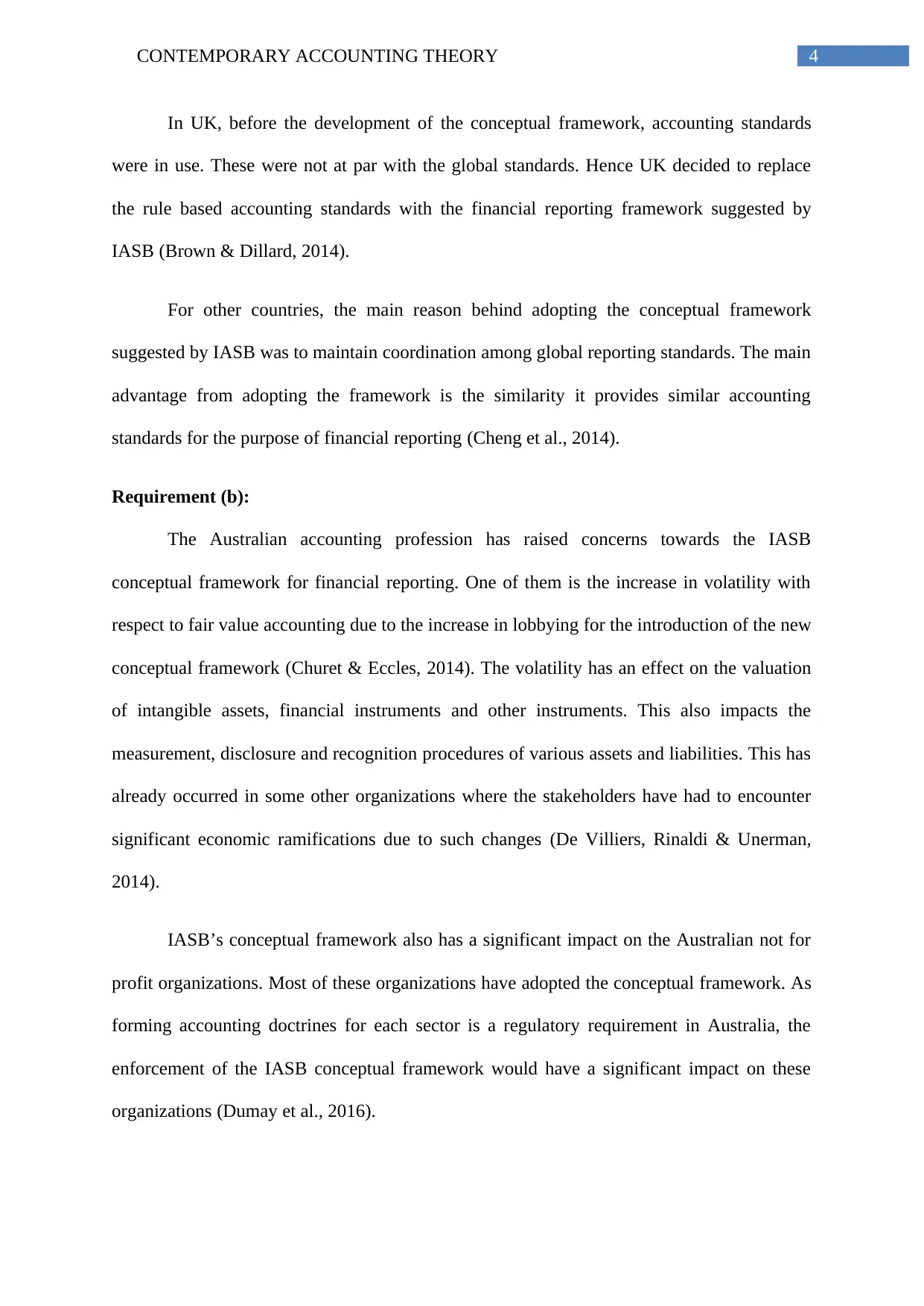
In UK, before the development of the conceptual framework, accounting standards
were in use. These were not at par with the global standards. Hence UK decided to replace
the rule based accounting standards with the financial reporting framework suggested by
IASB (Brown & Dillard, 2014).
For other countries, the main reason behind adopting the conceptual framework
suggested by IASB was to maintain coordination among global reporting standards. The main
advantage from adopting the framework is the similarity it provides similar accounting
standards for the purpose of financial reporting (Cheng et al., 2014).
Requirement (b):
The Australian accounting profession has raised concerns towards the IASB
conceptual framework for financial reporting. One of them is the increase in volatility with
respect to fair value accounting due to the increase in lobbying for the introduction of the new
conceptual framework (Churet & Eccles, 2014). The volatility has an effect on the valuation
of intangible assets, financial instruments and other instruments. This also impacts the
measurement, disclosure and recognition procedures of various assets and liabilities. This has
already occurred in some other organizations where the stakeholders have had to encounter
significant economic ramifications due to such changes (De Villiers, Rinaldi & Unerman,
2014).
IASB’s conceptual framework also has a significant impact on the Australian not for
profit organizations. Most of these organizations have adopted the conceptual framework. As
forming accounting doctrines for each sector is a regulatory requirement in Australia, the
enforcement of the IASB conceptual framework would have a significant impact on these
organizations (Dumay et al., 2016).
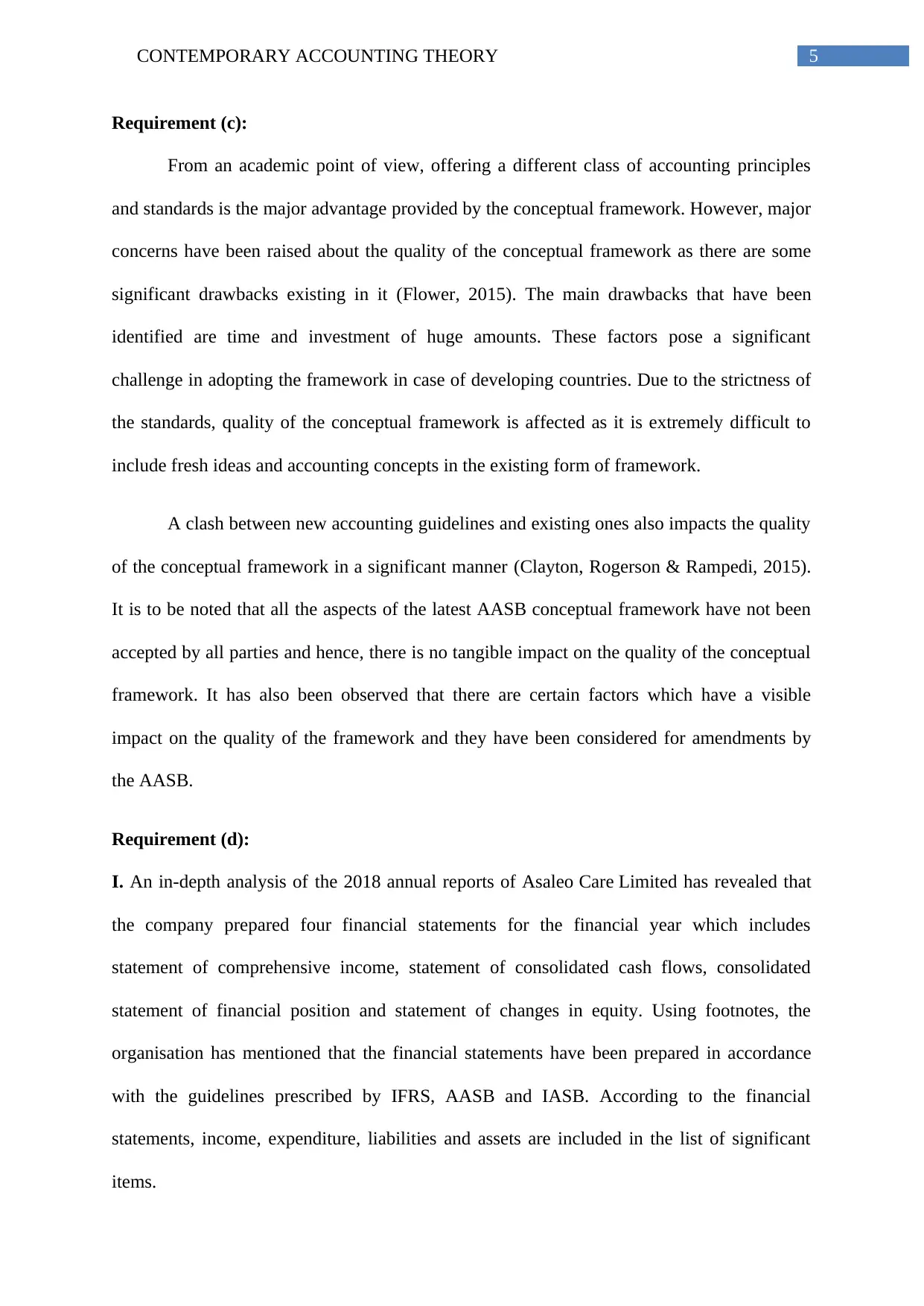
Requirement (c):
From an academic point of view, offering a different class of accounting principles
and standards is the major advantage provided by the conceptual framework. However, major
concerns have been raised about the quality of the conceptual framework as there are some
significant drawbacks existing in it (Flower, 2015). The main drawbacks that have been
identified are time and investment of huge amounts. These factors pose a significant
challenge in adopting the framework in case of developing countries. Due to the strictness of
the standards, quality of the conceptual framework is affected as it is extremely difficult to
include fresh ideas and accounting concepts in the existing form of framework.
A clash between new accounting guidelines and existing ones also impacts the quality
of the conceptual framework in a significant manner (Clayton, Rogerson & Rampedi, 2015).
It is to be noted that all the aspects of the latest AASB conceptual framework have not been
accepted by all parties and hence, there is no tangible impact on the quality of the conceptual
framework. It has also been observed that there are certain factors which have a visible
impact on the quality of the framework and they have been considered for amendments by
the AASB.
Requirement (d):
I. An in-depth analysis of the 2018 annual reports of Asaleo Care Limited has revealed that
the company prepared four financial statements for the financial year which includes
statement of comprehensive income, statement of consolidated cash flows, consolidated
statement of financial position and statement of changes in equity. Using footnotes, the
organisation has mentioned that the financial statements have been prepared in accordance
with the guidelines prescribed by IFRS, AASB and IASB. According to the financial
statements, income, expenditure, liabilities and assets are included in the list of significant
items.
⊘ This is a preview!⊘
Do you want full access?
Subscribe today to unlock all pages.

Trusted by 1+ million students worldwide
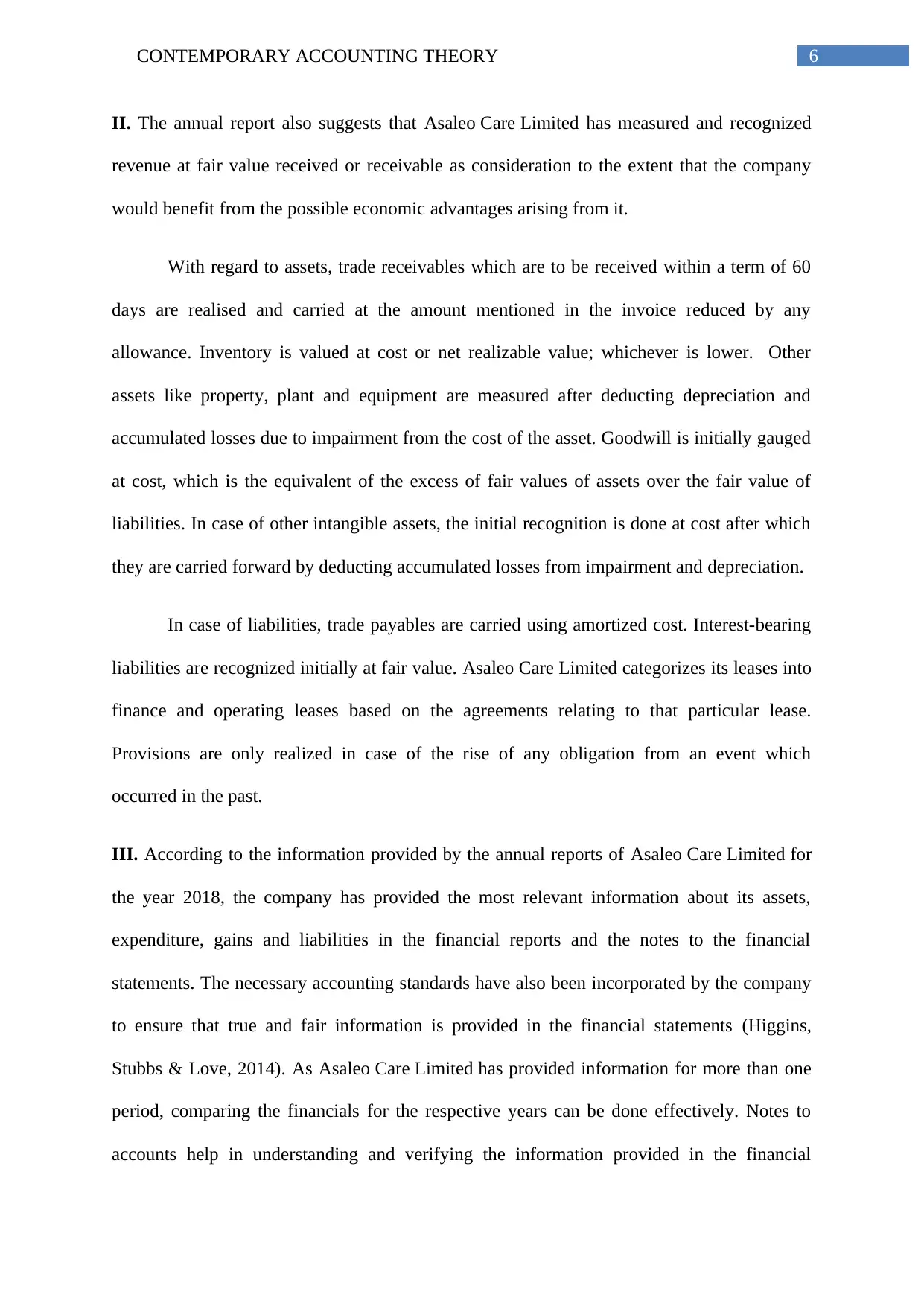
II. The annual report also suggests that Asaleo Care Limited has measured and recognized
revenue at fair value received or receivable as consideration to the extent that the company
would benefit from the possible economic advantages arising from it.
With regard to assets, trade receivables which are to be received within a term of 60
days are realised and carried at the amount mentioned in the invoice reduced by any
allowance. Inventory is valued at cost or net realizable value; whichever is lower. Other
assets like property, plant and equipment are measured after deducting depreciation and
accumulated losses due to impairment from the cost of the asset. Goodwill is initially gauged
at cost, which is the equivalent of the excess of fair values of assets over the fair value of
liabilities. In case of other intangible assets, the initial recognition is done at cost after which
they are carried forward by deducting accumulated losses from impairment and depreciation.
In case of liabilities, trade payables are carried using amortized cost. Interest-bearing
liabilities are recognized initially at fair value. Asaleo Care Limited categorizes its leases into
finance and operating leases based on the agreements relating to that particular lease.
Provisions are only realized in case of the rise of any obligation from an event which
occurred in the past.
III. According to the information provided by the annual reports of Asaleo Care Limited for
the year 2018, the company has provided the most relevant information about its assets,
expenditure, gains and liabilities in the financial reports and the notes to the financial
statements. The necessary accounting standards have also been incorporated by the company
to ensure that true and fair information is provided in the financial statements (Higgins,
Stubbs & Love, 2014). As Asaleo Care Limited has provided information for more than one
period, comparing the financials for the respective years can be done effectively. Notes to
accounts help in understanding and verifying the information provided in the financial
Paraphrase This Document
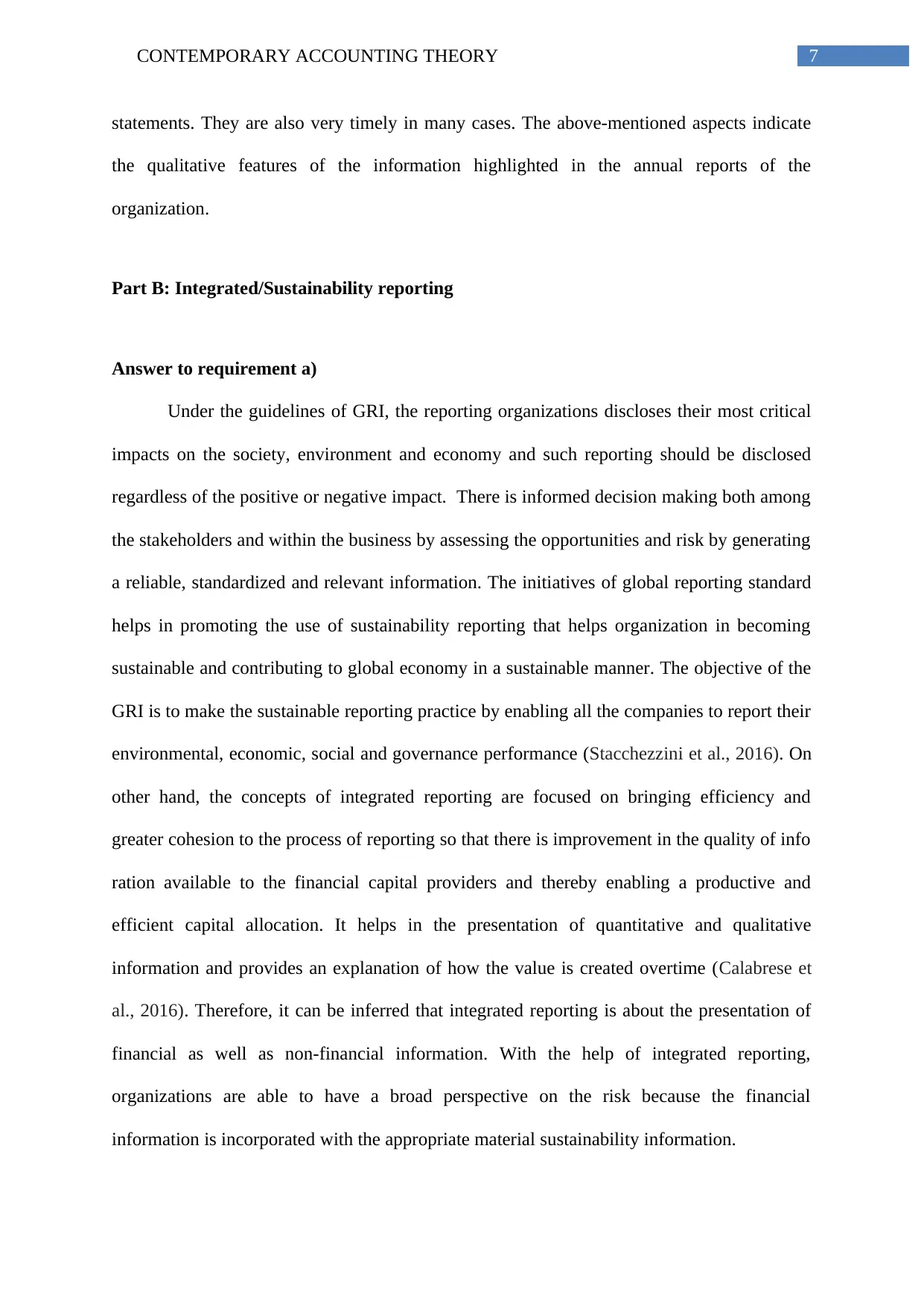
statements. They are also very timely in many cases. The above-mentioned aspects indicate
the qualitative features of the information highlighted in the annual reports of the
organization.
Part B: Integrated/Sustainability reporting
Answer to requirement a)
Under the guidelines of GRI, the reporting organizations discloses their most critical
impacts on the society, environment and economy and such reporting should be disclosed
regardless of the positive or negative impact. There is informed decision making both among
the stakeholders and within the business by assessing the opportunities and risk by generating
a reliable, standardized and relevant information. The initiatives of global reporting standard
helps in promoting the use of sustainability reporting that helps organization in becoming
sustainable and contributing to global economy in a sustainable manner. The objective of the
GRI is to make the sustainable reporting practice by enabling all the companies to report their
environmental, economic, social and governance performance (Stacchezzini et al., 2016). On
other hand, the concepts of integrated reporting are focused on bringing efficiency and
greater cohesion to the process of reporting so that there is improvement in the quality of info
ration available to the financial capital providers and thereby enabling a productive and
efficient capital allocation. It helps in the presentation of quantitative and qualitative
information and provides an explanation of how the value is created overtime (Calabrese et
al., 2016). Therefore, it can be inferred that integrated reporting is about the presentation of
financial as well as non-financial information. With the help of integrated reporting,
organizations are able to have a broad perspective on the risk because the financial
information is incorporated with the appropriate material sustainability information.
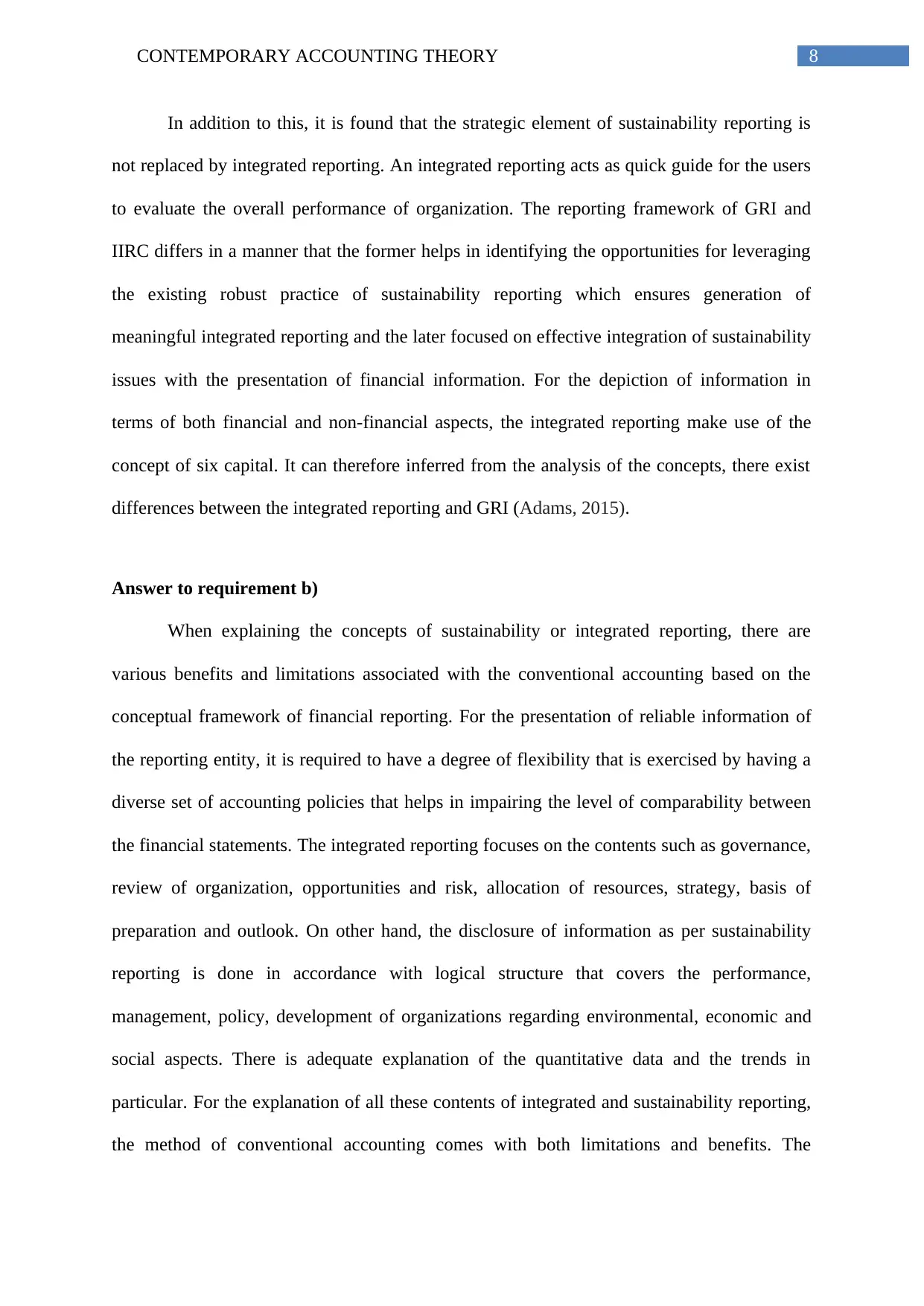
In addition to this, it is found that the strategic element of sustainability reporting is
not replaced by integrated reporting. An integrated reporting acts as quick guide for the users
to evaluate the overall performance of organization. The reporting framework of GRI and
IIRC differs in a manner that the former helps in identifying the opportunities for leveraging
the existing robust practice of sustainability reporting which ensures generation of
meaningful integrated reporting and the later focused on effective integration of sustainability
issues with the presentation of financial information. For the depiction of information in
terms of both financial and non-financial aspects, the integrated reporting make use of the
concept of six capital. It can therefore inferred from the analysis of the concepts, there exist
differences between the integrated reporting and GRI (Adams, 2015).
Answer to requirement b)
When explaining the concepts of sustainability or integrated reporting, there are
various benefits and limitations associated with the conventional accounting based on the
conceptual framework of financial reporting. For the presentation of reliable information of
the reporting entity, it is required to have a degree of flexibility that is exercised by having a
diverse set of accounting policies that helps in impairing the level of comparability between
the financial statements. The integrated reporting focuses on the contents such as governance,
review of organization, opportunities and risk, allocation of resources, strategy, basis of
preparation and outlook. On other hand, the disclosure of information as per sustainability
reporting is done in accordance with logical structure that covers the performance,
management, policy, development of organizations regarding environmental, economic and
social aspects. There is adequate explanation of the quantitative data and the trends in
particular. For the explanation of all these contents of integrated and sustainability reporting,
the method of conventional accounting comes with both limitations and benefits. The
⊘ This is a preview!⊘
Do you want full access?
Subscribe today to unlock all pages.

Trusted by 1+ million students worldwide
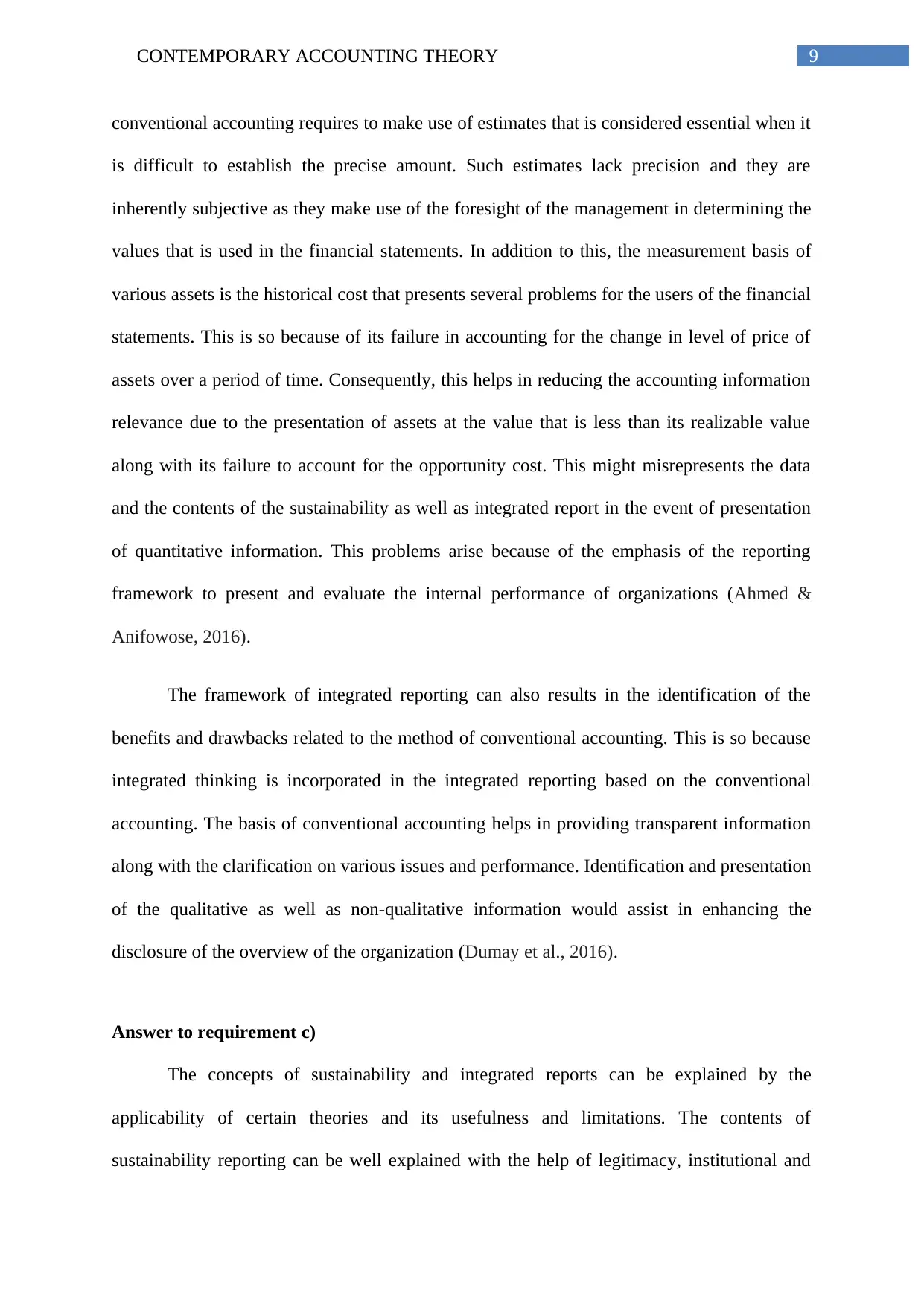
conventional accounting requires to make use of estimates that is considered essential when it
is difficult to establish the precise amount. Such estimates lack precision and they are
inherently subjective as they make use of the foresight of the management in determining the
values that is used in the financial statements. In addition to this, the measurement basis of
various assets is the historical cost that presents several problems for the users of the financial
statements. This is so because of its failure in accounting for the change in level of price of
assets over a period of time. Consequently, this helps in reducing the accounting information
relevance due to the presentation of assets at the value that is less than its realizable value
along with its failure to account for the opportunity cost. This might misrepresents the data
and the contents of the sustainability as well as integrated report in the event of presentation
of quantitative information. This problems arise because of the emphasis of the reporting
framework to present and evaluate the internal performance of organizations (Ahmed &
Anifowose, 2016).
The framework of integrated reporting can also results in the identification of the
benefits and drawbacks related to the method of conventional accounting. This is so because
integrated thinking is incorporated in the integrated reporting based on the conventional
accounting. The basis of conventional accounting helps in providing transparent information
along with the clarification on various issues and performance. Identification and presentation
of the qualitative as well as non-qualitative information would assist in enhancing the
disclosure of the overview of the organization (Dumay et al., 2016).
Answer to requirement c)
The concepts of sustainability and integrated reports can be explained by the
applicability of certain theories and its usefulness and limitations. The contents of
sustainability reporting can be well explained with the help of legitimacy, institutional and
Paraphrase This Document
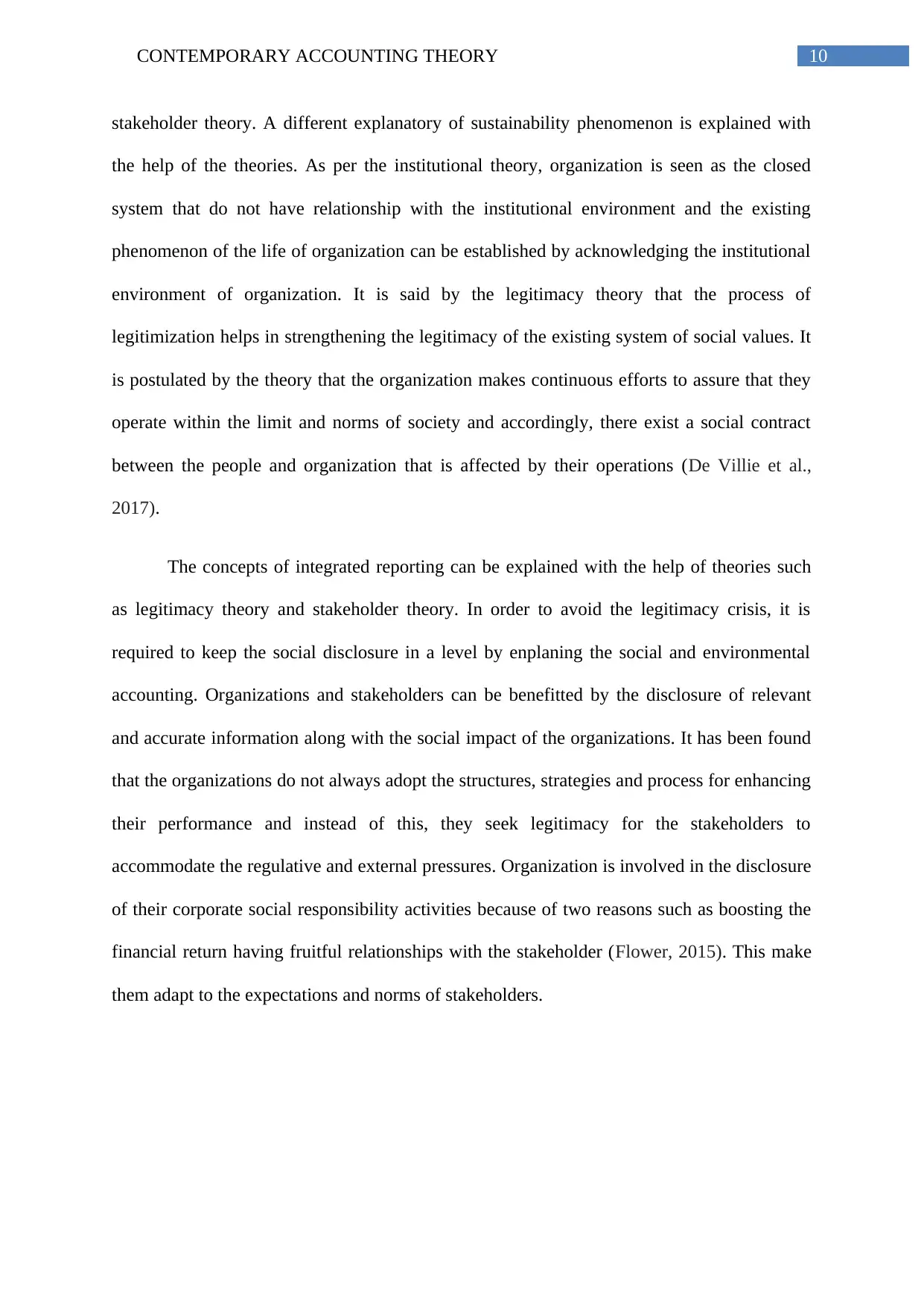
stakeholder theory. A different explanatory of sustainability phenomenon is explained with
the help of the theories. As per the institutional theory, organization is seen as the closed
system that do not have relationship with the institutional environment and the existing
phenomenon of the life of organization can be established by acknowledging the institutional
environment of organization. It is said by the legitimacy theory that the process of
legitimization helps in strengthening the legitimacy of the existing system of social values. It
is postulated by the theory that the organization makes continuous efforts to assure that they
operate within the limit and norms of society and accordingly, there exist a social contract
between the people and organization that is affected by their operations (De Villie et al.,
2017).
The concepts of integrated reporting can be explained with the help of theories such
as legitimacy theory and stakeholder theory. In order to avoid the legitimacy crisis, it is
required to keep the social disclosure in a level by enplaning the social and environmental
accounting. Organizations and stakeholders can be benefitted by the disclosure of relevant
and accurate information along with the social impact of the organizations. It has been found
that the organizations do not always adopt the structures, strategies and process for enhancing
their performance and instead of this, they seek legitimacy for the stakeholders to
accommodate the regulative and external pressures. Organization is involved in the disclosure
of their corporate social responsibility activities because of two reasons such as boosting the
financial return having fruitful relationships with the stakeholder (Flower, 2015). This make
them adapt to the expectations and norms of stakeholders.
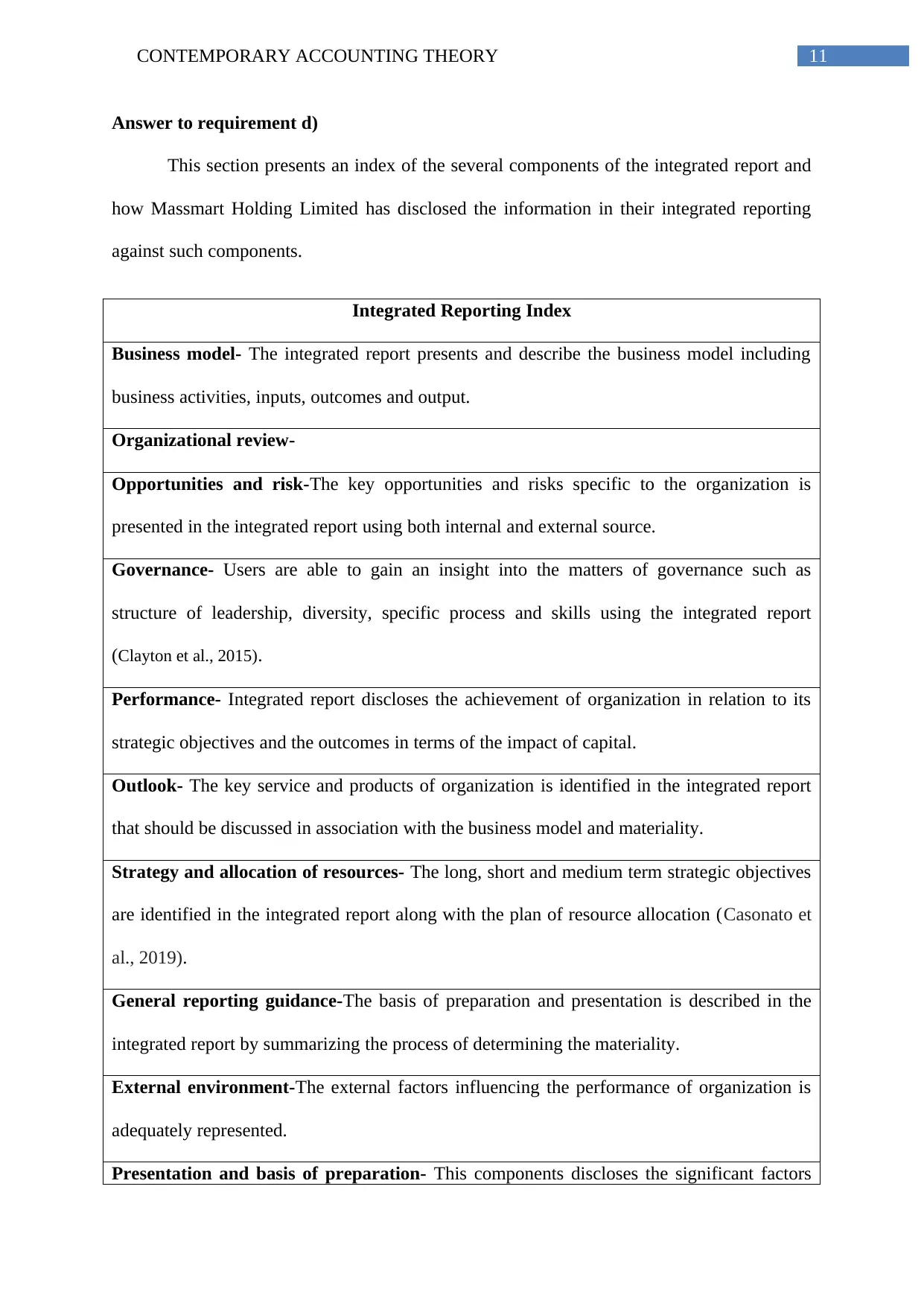
Answer to requirement d)
This section presents an index of the several components of the integrated report and
how Massmart Holding Limited has disclosed the information in their integrated reporting
against such components.
Integrated Reporting Index
Business model- The integrated report presents and describe the business model including
business activities, inputs, outcomes and output.
Organizational review-
Opportunities and risk-The key opportunities and risks specific to the organization is
presented in the integrated report using both internal and external source.
Governance- Users are able to gain an insight into the matters of governance such as
structure of leadership, diversity, specific process and skills using the integrated report
(Clayton et al., 2015).
Performance- Integrated report discloses the achievement of organization in relation to its
strategic objectives and the outcomes in terms of the impact of capital.
Outlook- The key service and products of organization is identified in the integrated report
that should be discussed in association with the business model and materiality.
Strategy and allocation of resources- The long, short and medium term strategic objectives
are identified in the integrated report along with the plan of resource allocation (Casonato et
al., 2019).
General reporting guidance-The basis of preparation and presentation is described in the
integrated report by summarizing the process of determining the materiality.
External environment-The external factors influencing the performance of organization is
adequately represented.
Presentation and basis of preparation- This components discloses the significant factors
⊘ This is a preview!⊘
Do you want full access?
Subscribe today to unlock all pages.

Trusted by 1+ million students worldwide
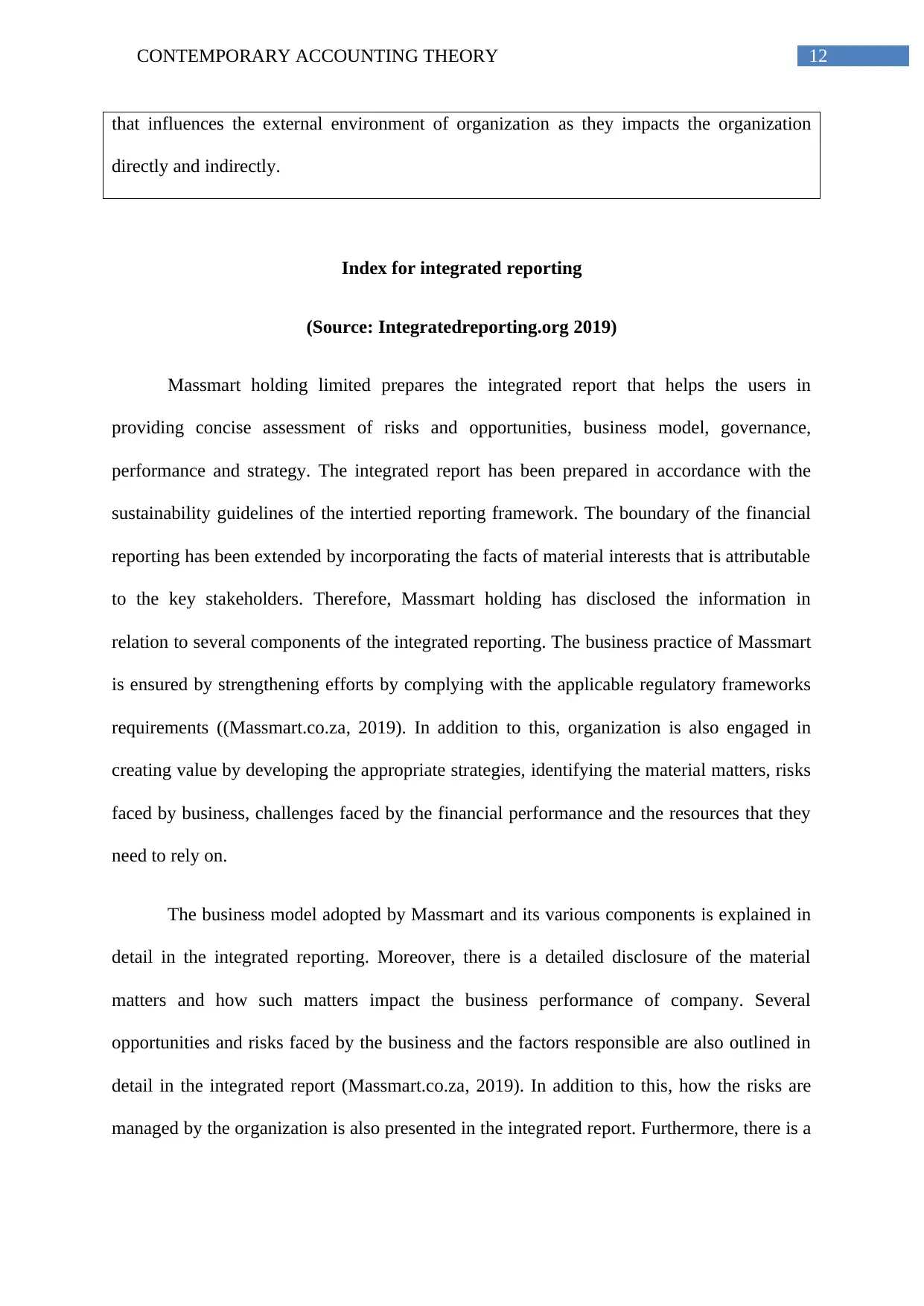
that influences the external environment of organization as they impacts the organization
directly and indirectly.
Index for integrated reporting
(Source: Integratedreporting.org 2019)
Massmart holding limited prepares the integrated report that helps the users in
providing concise assessment of risks and opportunities, business model, governance,
performance and strategy. The integrated report has been prepared in accordance with the
sustainability guidelines of the intertied reporting framework. The boundary of the financial
reporting has been extended by incorporating the facts of material interests that is attributable
to the key stakeholders. Therefore, Massmart holding has disclosed the information in
relation to several components of the integrated reporting. The business practice of Massmart
is ensured by strengthening efforts by complying with the applicable regulatory frameworks
requirements ((Massmart.co.za, 2019). In addition to this, organization is also engaged in
creating value by developing the appropriate strategies, identifying the material matters, risks
faced by business, challenges faced by the financial performance and the resources that they
need to rely on.
The business model adopted by Massmart and its various components is explained in
detail in the integrated reporting. Moreover, there is a detailed disclosure of the material
matters and how such matters impact the business performance of company. Several
opportunities and risks faced by the business and the factors responsible are also outlined in
detail in the integrated report (Massmart.co.za, 2019). In addition to this, how the risks are
managed by the organization is also presented in the integrated report. Furthermore, there is a
Paraphrase This Document
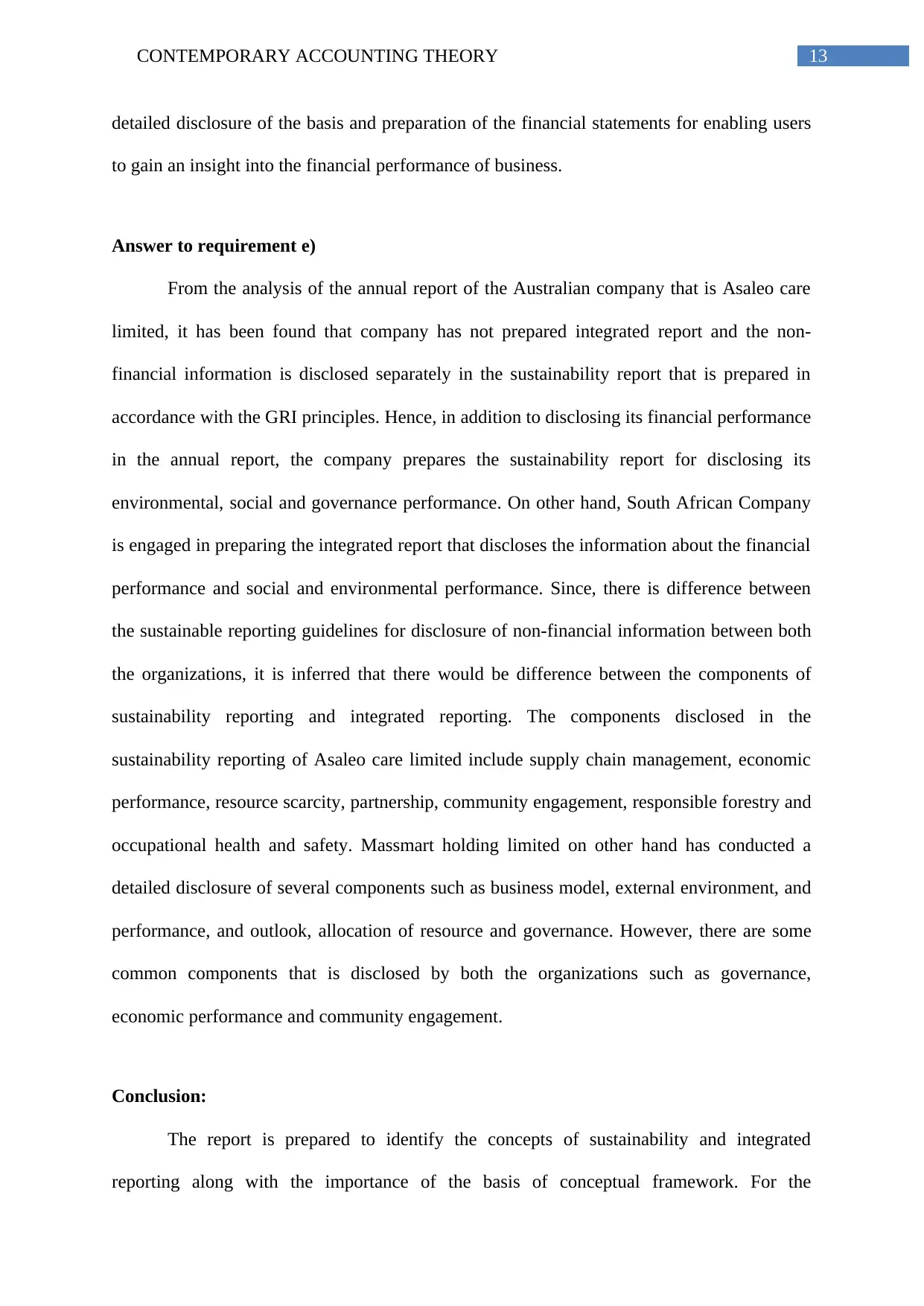
detailed disclosure of the basis and preparation of the financial statements for enabling users
to gain an insight into the financial performance of business.
Answer to requirement e)
From the analysis of the annual report of the Australian company that is Asaleo care
limited, it has been found that company has not prepared integrated report and the non-
financial information is disclosed separately in the sustainability report that is prepared in
accordance with the GRI principles. Hence, in addition to disclosing its financial performance
in the annual report, the company prepares the sustainability report for disclosing its
environmental, social and governance performance. On other hand, South African Company
is engaged in preparing the integrated report that discloses the information about the financial
performance and social and environmental performance. Since, there is difference between
the sustainable reporting guidelines for disclosure of non-financial information between both
the organizations, it is inferred that there would be difference between the components of
sustainability reporting and integrated reporting. The components disclosed in the
sustainability reporting of Asaleo care limited include supply chain management, economic
performance, resource scarcity, partnership, community engagement, responsible forestry and
occupational health and safety. Massmart holding limited on other hand has conducted a
detailed disclosure of several components such as business model, external environment, and
performance, and outlook, allocation of resource and governance. However, there are some
common components that is disclosed by both the organizations such as governance,
economic performance and community engagement.
Conclusion:
The report is prepared to identify the concepts of sustainability and integrated
reporting along with the importance of the basis of conceptual framework. For the
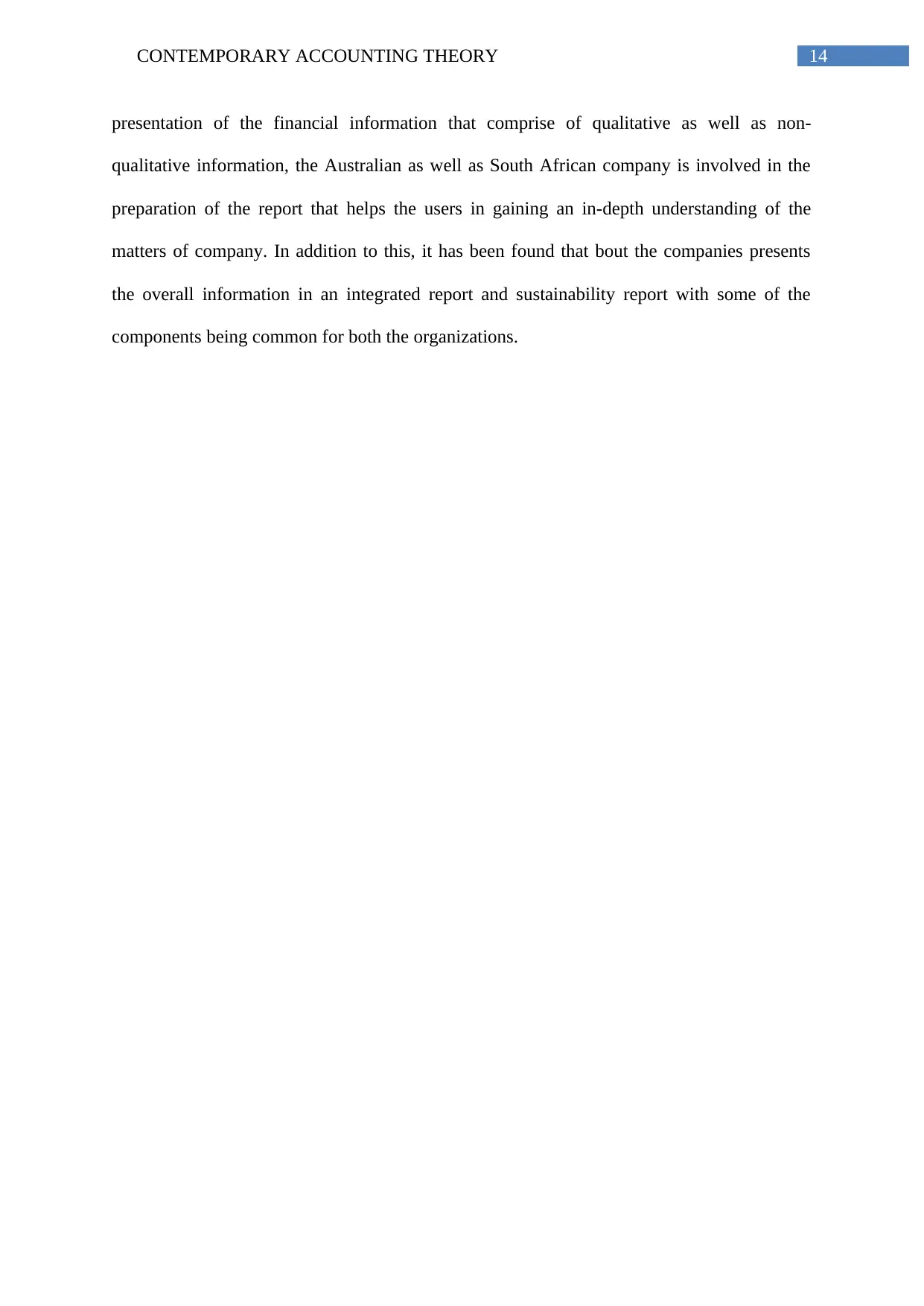
presentation of the financial information that comprise of qualitative as well as non-
qualitative information, the Australian as well as South African company is involved in the
preparation of the report that helps the users in gaining an in-depth understanding of the
matters of company. In addition to this, it has been found that bout the companies presents
the overall information in an integrated report and sustainability report with some of the
components being common for both the organizations.
⊘ This is a preview!⊘
Do you want full access?
Subscribe today to unlock all pages.

Trusted by 1+ million students worldwide
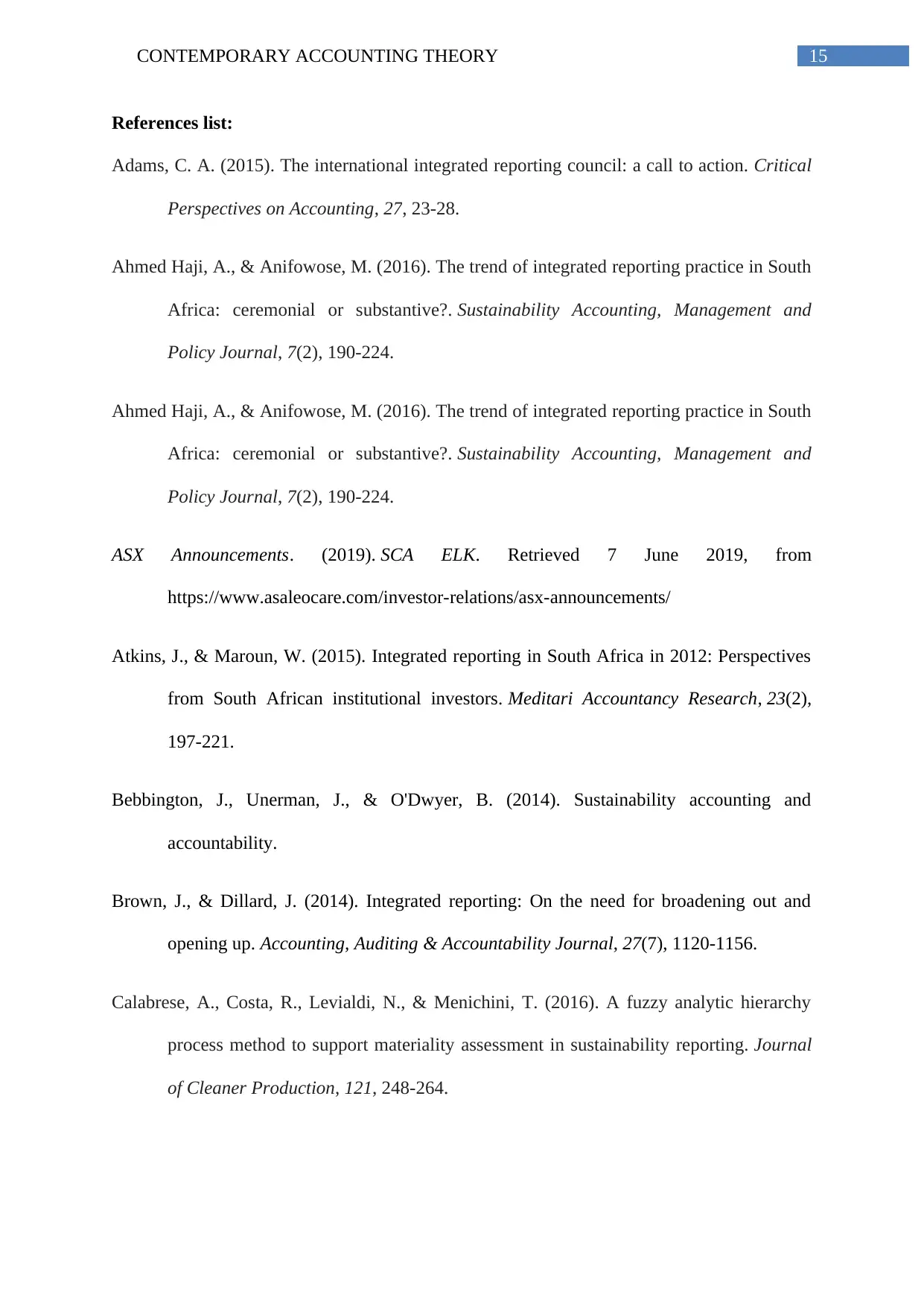
References list:
Adams, C. A. (2015). The international integrated reporting council: a call to action. Critical
Perspectives on Accounting, 27, 23-28.
Ahmed Haji, A., & Anifowose, M. (2016). The trend of integrated reporting practice in South
Africa: ceremonial or substantive?. Sustainability Accounting, Management and
Policy Journal, 7(2), 190-224.
Ahmed Haji, A., & Anifowose, M. (2016). The trend of integrated reporting practice in South
Africa: ceremonial or substantive?. Sustainability Accounting, Management and
Policy Journal, 7(2), 190-224.
ASX Announcements. (2019). SCA ELK. Retrieved 7 June 2019, from
https://www.asaleocare.com/investor-relations/asx-announcements/
Atkins, J., & Maroun, W. (2015). Integrated reporting in South Africa in 2012: Perspectives
from South African institutional investors. Meditari Accountancy Research, 23(2),
197-221.
Bebbington, J., Unerman, J., & O'Dwyer, B. (2014). Sustainability accounting and
accountability.
Brown, J., & Dillard, J. (2014). Integrated reporting: On the need for broadening out and
opening up. Accounting, Auditing & Accountability Journal, 27(7), 1120-1156.
Calabrese, A., Costa, R., Levialdi, N., & Menichini, T. (2016). A fuzzy analytic hierarchy
process method to support materiality assessment in sustainability reporting. Journal
of Cleaner Production, 121, 248-264.
Paraphrase This Document
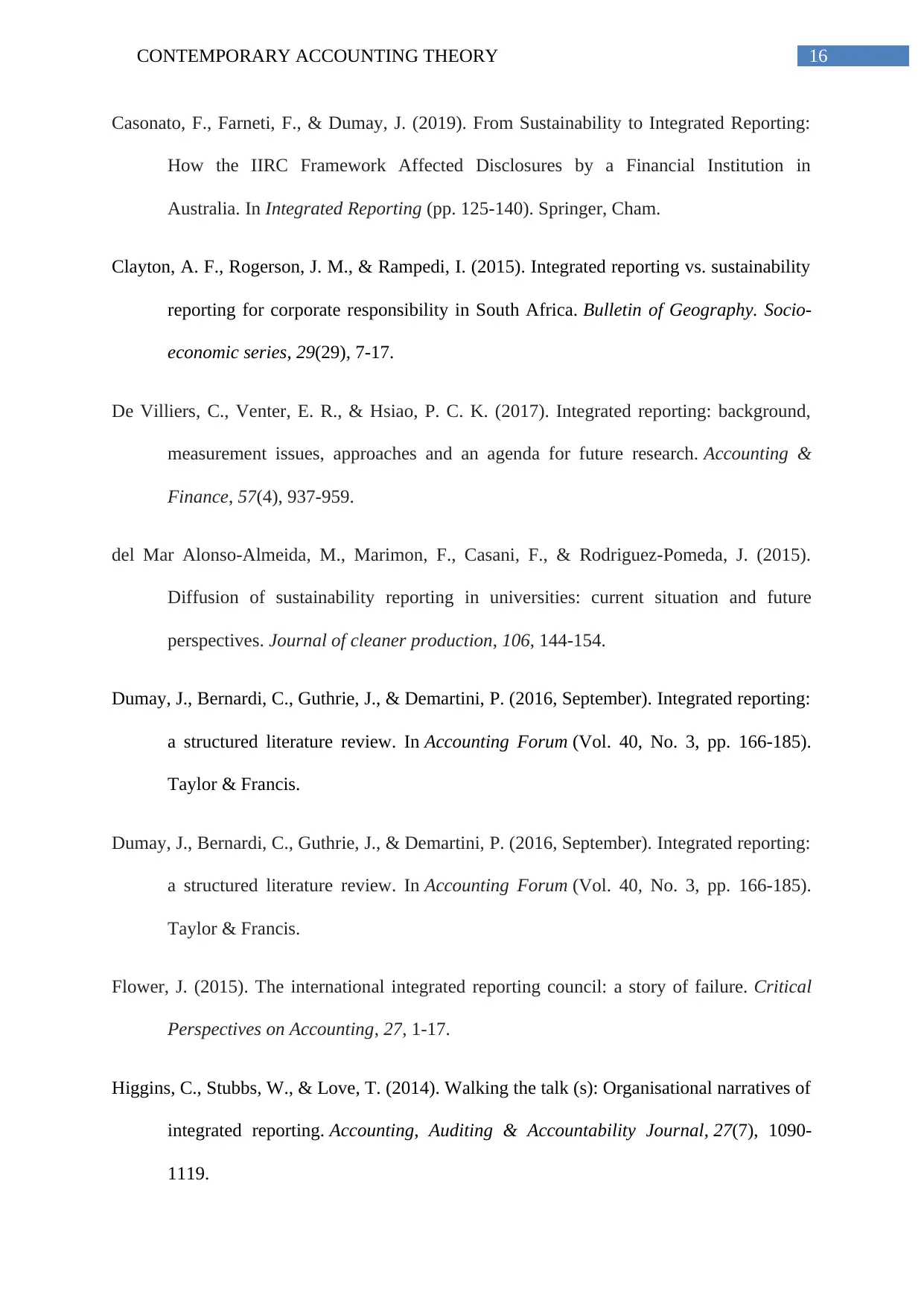
Casonato, F., Farneti, F., & Dumay, J. (2019). From Sustainability to Integrated Reporting:
How the IIRC Framework Affected Disclosures by a Financial Institution in
Australia. In Integrated Reporting (pp. 125-140). Springer, Cham.
Clayton, A. F., Rogerson, J. M., & Rampedi, I. (2015). Integrated reporting vs. sustainability
reporting for corporate responsibility in South Africa. Bulletin of Geography. Socio-
economic series, 29(29), 7-17.
De Villiers, C., Venter, E. R., & Hsiao, P. C. K. (2017). Integrated reporting: background,
measurement issues, approaches and an agenda for future research. Accounting &
Finance, 57(4), 937-959.
del Mar Alonso-Almeida, M., Marimon, F., Casani, F., & Rodriguez-Pomeda, J. (2015).
Diffusion of sustainability reporting in universities: current situation and future
perspectives. Journal of cleaner production, 106, 144-154.
Dumay, J., Bernardi, C., Guthrie, J., & Demartini, P. (2016, September). Integrated reporting:
a structured literature review. In Accounting Forum (Vol. 40, No. 3, pp. 166-185).
Taylor & Francis.
Dumay, J., Bernardi, C., Guthrie, J., & Demartini, P. (2016, September). Integrated reporting:
a structured literature review. In Accounting Forum (Vol. 40, No. 3, pp. 166-185).
Taylor & Francis.
Flower, J. (2015). The international integrated reporting council: a story of failure. Critical
Perspectives on Accounting, 27, 1-17.
Higgins, C., Stubbs, W., & Love, T. (2014). Walking the talk (s): Organisational narratives of
integrated reporting. Accounting, Auditing & Accountability Journal, 27(7), 1090-
1119.
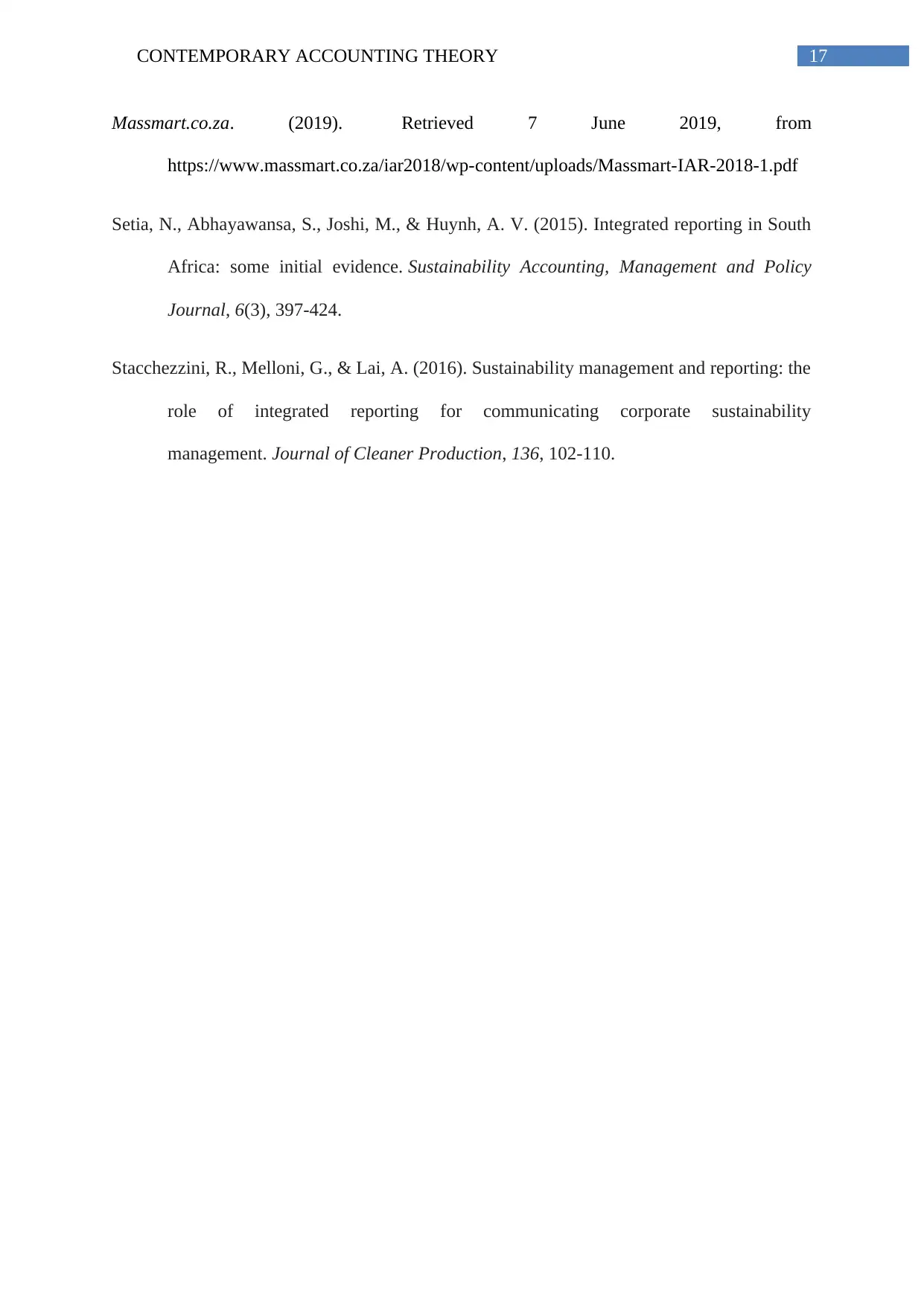
Massmart.co.za. (2019). Retrieved 7 June 2019, from
https://www.massmart.co.za/iar2018/wp-content/uploads/Massmart-IAR-2018-1.pdf
Setia, N., Abhayawansa, S., Joshi, M., & Huynh, A. V. (2015). Integrated reporting in South
Africa: some initial evidence. Sustainability Accounting, Management and Policy
Journal, 6(3), 397-424.
Stacchezzini, R., Melloni, G., & Lai, A. (2016). Sustainability management and reporting: the
role of integrated reporting for communicating corporate sustainability
management. Journal of Cleaner Production, 136, 102-110.
⊘ This is a preview!⊘
Do you want full access?
Subscribe today to unlock all pages.

Trusted by 1+ million students worldwide
Related Documents
Your All-in-One AI-Powered Toolkit for Academic Success.
+13062052269
info@desklib.com
Available 24*7 on WhatsApp / Email
![[object Object]](/_next/static/media/star-bottom.7253800d.svg)
© 2024 | Zucol Services PVT LTD | All rights reserved.





